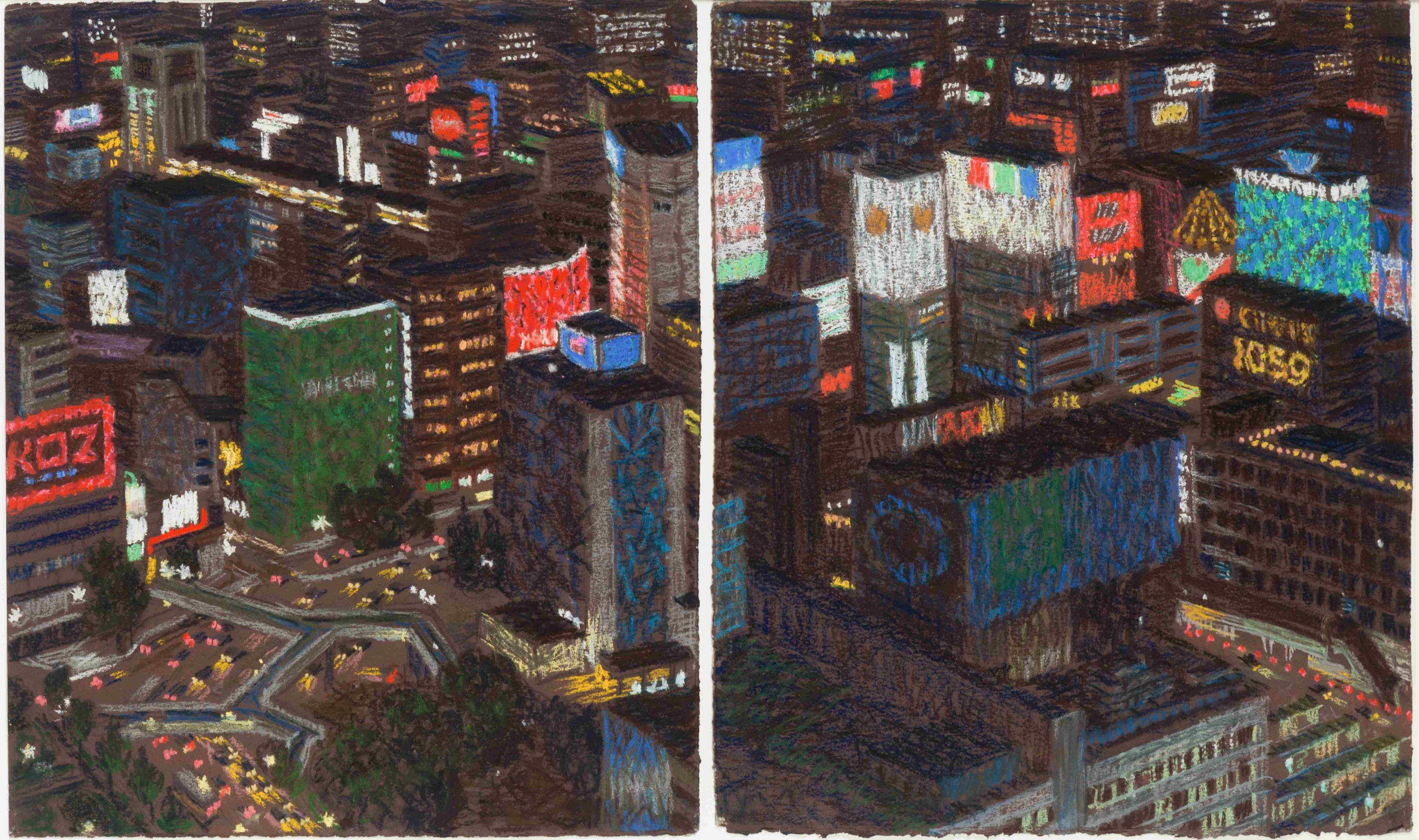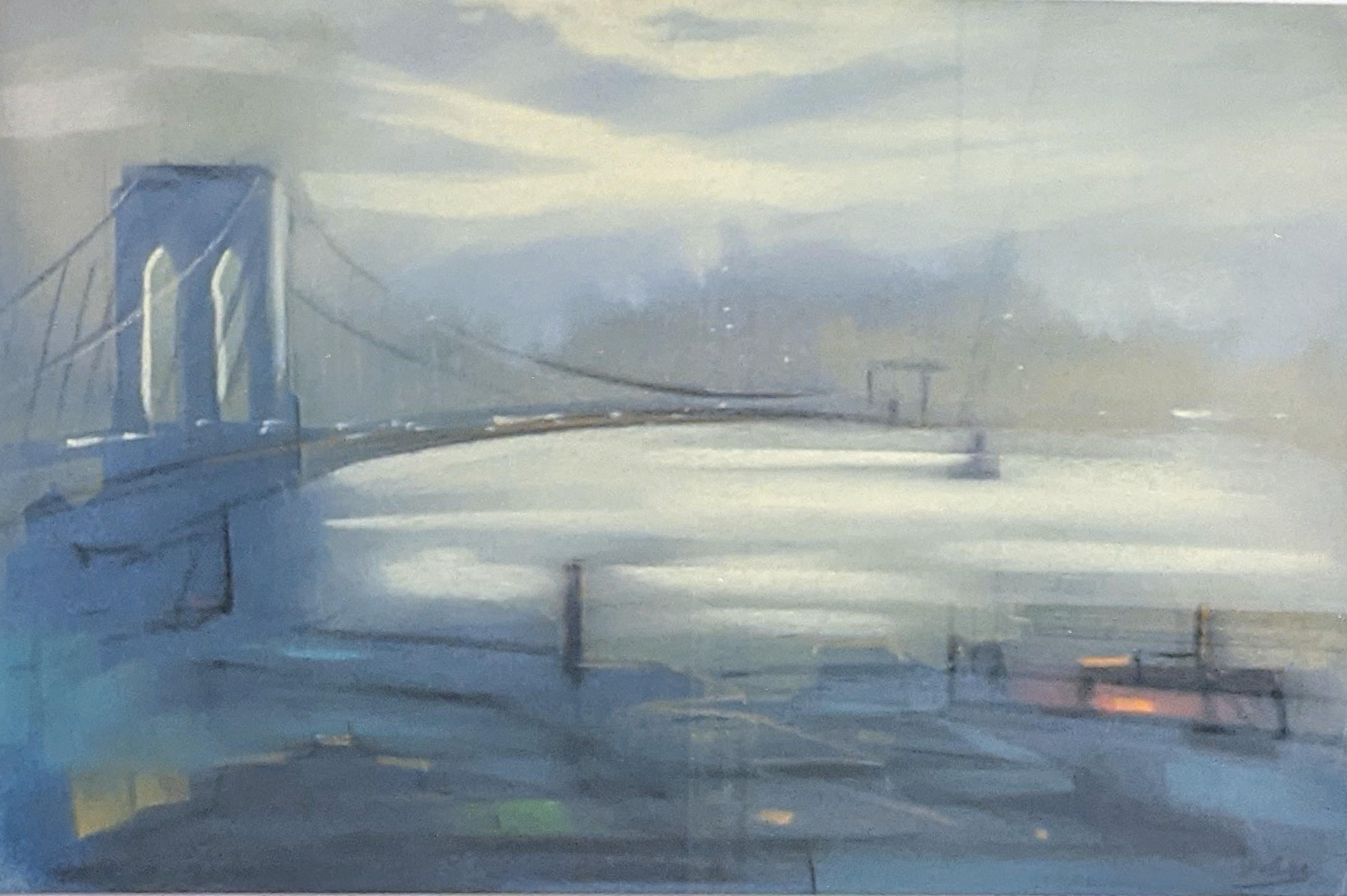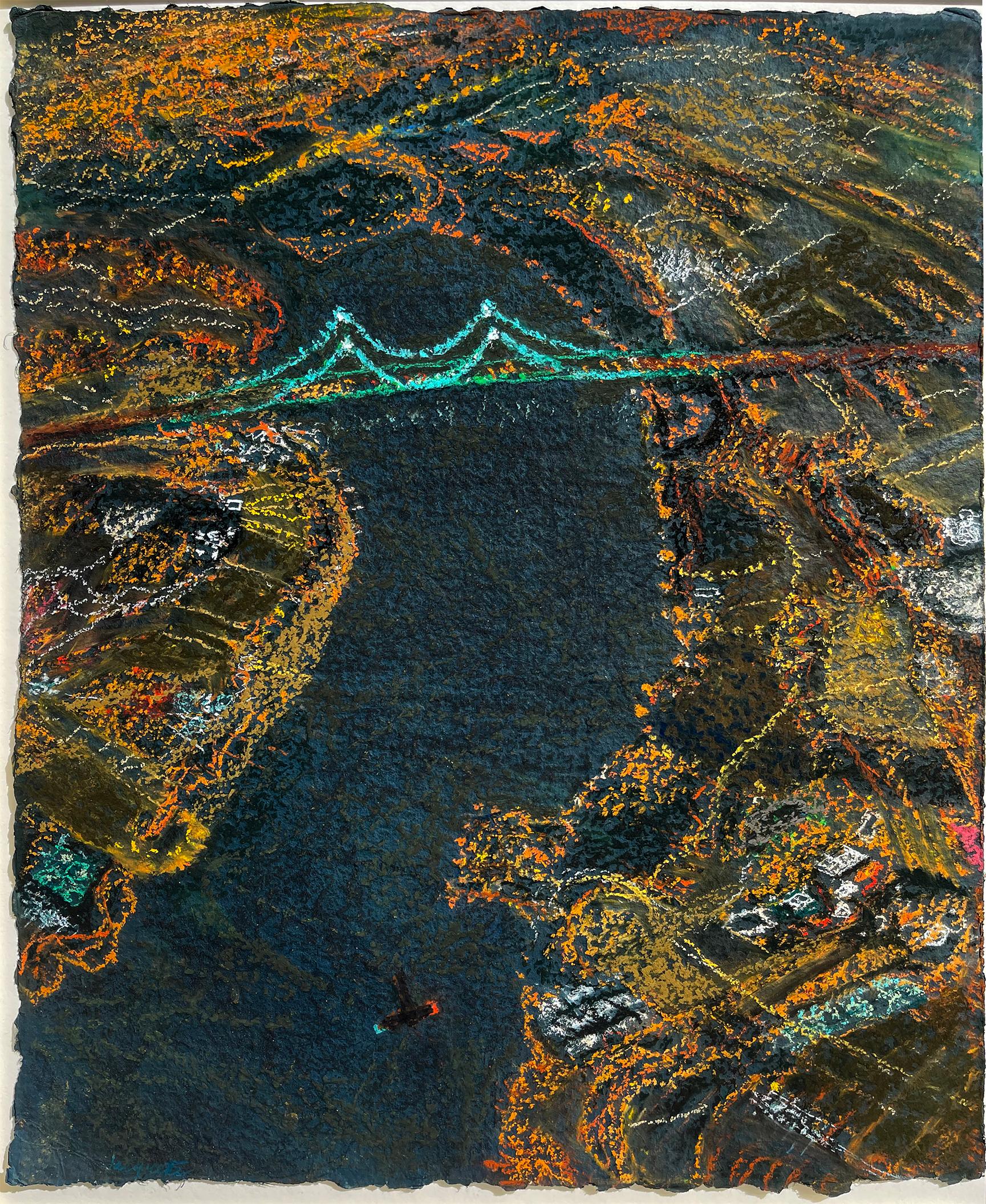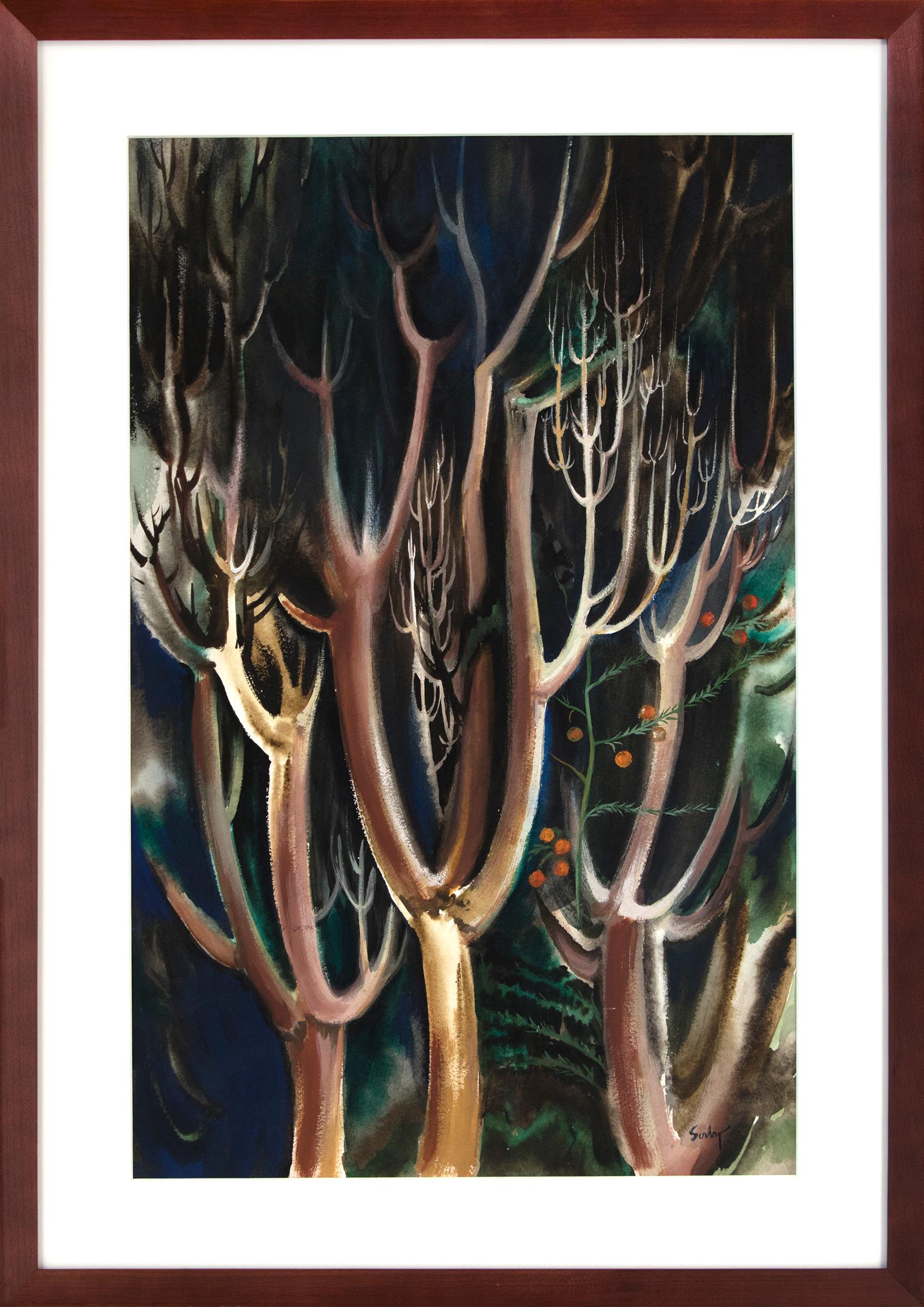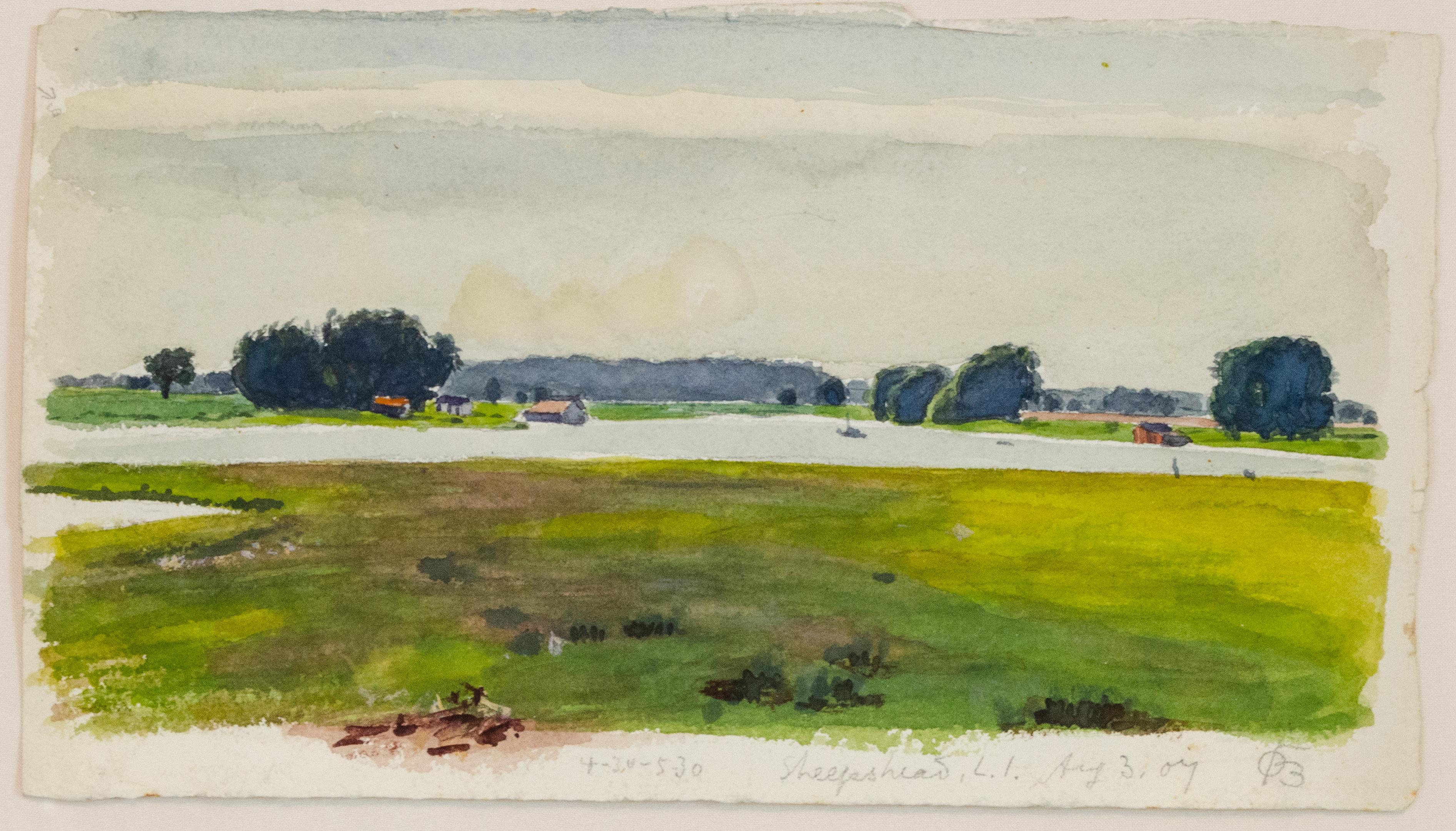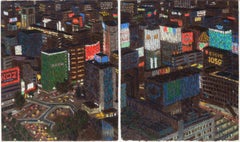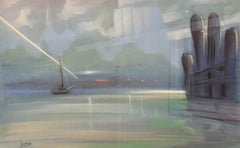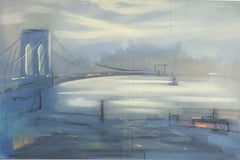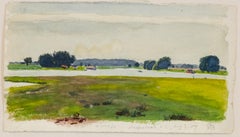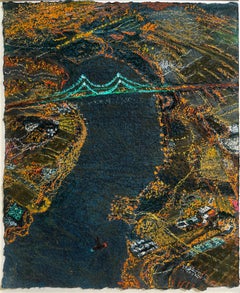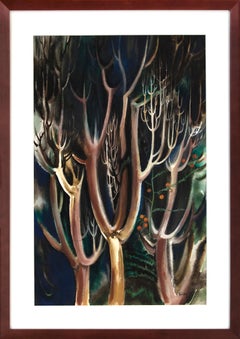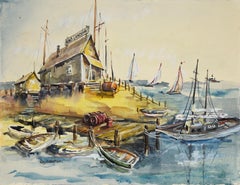Items Similar to "Hydrangeas, " Walter Inglis Anderson, Mississippi Southern Illustrator, Flowers
Want more images or videos?
Request additional images or videos from the seller
1 of 7
Walter Inglis Anderson"Hydrangeas, " Walter Inglis Anderson, Mississippi Southern Illustrator, Flowerscirca 1950
circa 1950
About the Item
Walter Anderson ( American, 1903 - 1965)
Hydrangeas, circa 1950
Mixed media on paper
11 x 8 1/2 inches
Provenance:
Luise Ross Gallery, New York
Private Collection, New Jersey
Acquired from the estate of the above, 2021
Walter Anderson firmly believed that quality art was an important part of life and should be made available to everyone. As he said, "There should be simple, good decorations, to be sold at prices to rival the five-and-ten." Noticing that only poor quality art was available in stores and little was available for children, he resolved to make art which could be reproduced easily and sell inexpensively — linoleum block prints. This technique enabled him to provide affordable, quality art.
The technique of linoleum block printing is a simple concept; however, it requires much skill and talent to actually produce memorable art. Anderson purchased surplus "battleship linoleum," thicker than ordinary linoleum with a burlap backing for better support, to create his blocks. During the mid-1940s, he created almost 300 linocuts working in the attic of the sea-side plantation house, Oldfields, his wife's family home in Gautier. Masses of linoleum chips accumulated at the foot of the attic stairs as he often worked night and day. He began with sketching out a design directly on the linoleum. Once he had carved the image into the surface, he used the back of faded, surplus stock wallpaper that a friend sent him, laying long strips on top of the inked linoleum. A roller made of sewer pipe filled with sand served as his press. When the print was completed, he often colored it by hand with bold strokes and vivid colors. The prints were sold at Shearwater Pottery, the family business, for a mere dollar a foot.
But "what about a well-designed fairy tale for a child's room?" he asked himself. Since there was a lack of affordable art for children, much of his work with linoleum blocks focused on subjects for children. He depicted fables and fairy tales ranging from Arabian Nights, to Germany and the Grimm Brothers' Rapunzel, to the French story of The White Cat, to the Greek tales such as Europa and the Bull, and to tales from China, India, and other cultures. Anderson also created "mini" books featuring the alphabet and Robinson Cat. The blocks are not only alive with the story being depicted, but they are also filled with designs taken from Best-Maugard's Method for Creative Design. Swirls, half-circles and zig-zag lines fill every available space on the linoleum block making them come alive and capture their audience.
But fairy tales, children's verses and the "mini" books, consisting of about 90 blocks, were not the sole subject of Anderson's linoleum block prints. In total, he created approximately 300 linoleum blocks with subjects ranging from coastal flora and fauna, coastal animals, and sports and other coastal activities. Anderson even created linoleum blocks to be used to print tablecloths and clothing, some worn by his own children. Color and subjects of the linoleum block prints were not the only things that got them noticed.
In 1945 when Anderson was creating these prints, the standard size of linoleum block prints was only 12 by 18 inches. These small dimensions were due to the common size of the paper available and the restrictions made by national competitions. Since Anderson used wallpaper and was not concerned with competitions, he was able to have creative freedom and make huge prints.
Anderson felt that the art available in five-and-dime stores not only was short on quality, but short on size. He decided to make large prints that hung like vertical scrolls or horizontal over-mantels. Therefore, he made many of his prints 60 to 100 inches in length or height by approximately 19 inches (to fit the wallpaper strips). According to Carole E. Thompson in Walter Anderson: Prints from Mississippi, the scale of Anderson's prints has made him the first American artist to create linoleum block prints on such a large scale.
By 1949, Anderson had an exhibition of his linoleum block prints, drawings, a few ceramics, and some wood sculptures at the Brooklyn Museum in New York. According to correspondence, the museum was interested in the prints of such works as King Arthur and Billy Goats Gruff. Anderson wrote of the Brooklyn Museum showing of the fairy tale block prints, "Fairy tales have been used so often as sedatives that it is usually forgotten that they are also explosions… small explosions that are so identified with the life of man that they stimulate without destroying life." He wrote to the curator about his concerns for art reaching the people: "I hope that you will be able to reach the people who cannot afford to pay a great deal for works of art but still have an appetite for beauty and the imaginative world of fairy tales." In saying this, Anderson reinforced his belief that art should be available to everyone.
Walter Anderson was a visionary with many mediums. Whether with murals, watercolors, painted pottery or linoleum block printing, his desire was to reach the people, for he strongly believed that art enhanced people's lives.
- Creator:Walter Inglis Anderson (1903 - 1965)
- Creation Year:circa 1950
- Dimensions:Height: 17.75 in (45.09 cm)Width: 15.25 in (38.74 cm)
- Medium:
- Movement & Style:
- Period:
- Condition:
- Gallery Location:New York, NY
- Reference Number:1stDibs: LU184129925182
About the Seller
5.0
Gold Seller
Premium sellers maintaining a 4.3+ rating and 24-hour response times
Established in 2022
1stDibs seller since 2022
98 sales on 1stDibs
Typical response time: <1 hour
- ShippingRetrieving quote...Shipping from: New York, NY
- Return Policy
Authenticity Guarantee
In the unlikely event there’s an issue with an item’s authenticity, contact us within 1 year for a full refund. DetailsMoney-Back Guarantee
If your item is not as described, is damaged in transit, or does not arrive, contact us within 7 days for a full refund. Details24-Hour Cancellation
You have a 24-hour grace period in which to reconsider your purchase, with no questions asked.Vetted Professional Sellers
Our world-class sellers must adhere to strict standards for service and quality, maintaining the integrity of our listings.Price-Match Guarantee
If you find that a seller listed the same item for a lower price elsewhere, we’ll match it.Trusted Global Delivery
Our best-in-class carrier network provides specialized shipping options worldwide, including custom delivery.More From This Seller
View All"Tokyo Diptych, " Yvonne Jacquette, Japanese Urban Cityscape Nocturnal Aerial
By Yvonne Jacquette
Located in New York, NY
Yvonne Jacquette (American, b. 1935)
Tokyo Diptych, 1985
Pastel on paper
Overall 17 1/4 x 28 1/2 inches
Signed lower center
Provenance:
Carey Ellis Company, Houston, Texas
Brooke Alexander, New York
Collection of an American Corporation
Exhibited:
New York, Brooke Alexander, Yvonne Jacquette: Tokyo Nightviews, April 5 - May 3, 1986, n.p., illustrated; this exhibition later traveled to Brunswick, Maine, Bowdoin College Museum of Art, Yvonne Jacquette: Tokyo Nightviews, June 27 - August 24, 1986.
Yvonne Jacquette has a preference for high places, a circling plane, a penthouse window, an aerie from which to watch the world. Her work has often depicted the city and man-made landscape from the vantage of angels. It is a privileged perspective, long loved by photographers, who were perhaps the first to recognize the geometric grandeur of the city below. That grandeur structures Jacquette's images but is not its full content. Her work attempts to resolve the visual and emotional pardoxes of the modern metropolis. Only from the tower is there the possibility of order and context. And unlaced beauty.
Jacquette first visited Japan in 1982. Nighttime Tokyo, its cars and crowds and canyons of loud Vegas neon, made a vivid and bewildering impression on her. The neon signs, pulsing, scaling the walls of high rises, fascinated the artist, "like Times Square spread over miles." Her fascination was equal parts marvel, confusion, and curiosity—the sparks of art. She returned to Tokyo in May of 1985, choosing hotel rooms with expansive vistas. From these views Jacquette excerpted images for a series of pastel night scenes. The basic forms and colors of each drawing were blocked in during night sessions by the window. She worked in the dark, selecting colors by flashlight. In daylight, she sharpened the geometry and corrected ambiguous passages. She refined the drawings further in the studio until the images read clearly. Photographic correctness was not important. The finished drawings are complete statements, not simply preparatory sketches for paintings. They have the authority of expert witness. In clear, discreet jots of pastel they record the performance of seeing, each touch of color attesting to a moment's close scrutiny.
Yvonne Jacquette was born on December 15, 1934 in Pittsburgh, Pennsylvania and grew up in Stamford, Connecticut. She attended the Rhode Island School of Design, Providence from 1952 to 1955, when she moved to New York City. Her late husband was photographer Rudy Burckhardt, and the couple were part of a circle of artist friends that included Fairfield Porter, Alex Katz, Red Grooms, and Mimi Gross. She continues to live and work in New York City, as well as in Searsmont, Maine.
A flight to San Diego in 1969 sparked Jacquette’s interest in aerial views, after which she began flying in commercial airliners to study cloud formations and weather patterns. She soon started sketching and painting the landscape as seen from above, beginning a process that has developed into a defining element of her art. Her first nocturnal painting...
Category
1980s American Modern Landscape Drawings and Watercolors
Materials
Paper, Pastel
"New York City Harbor" Leon Dolice, Downtown Skyline, East and Hudson River
By Leon Dolice
Located in New York, NY
Leon Dolice (1892 - 1960)
New York Harbor Skyline at Twilight (Searching), circa 1930-40
Pastel on paper
12 x 19 inches
Signed lower left
Provenance:
Spanierman Gallery, New York
The romantic backdrop of Vienna at the turn of the century had a life-long influence upon the young man who was someday to be spoken of as showing promise of becoming "one of the greatest etchers of all time". Leon Dolice, born in Vienna on August 14, 1892, even as a young boy, preferred the lure of painting to the scholastic studies which his early years had expected of him. His father was a machinist, which exposed the boy to welding and metal crafts.
However, his interest in art led him to abandon a secure future in the family business, and he spent most of his late teens and early twenties traveling through the capital cities of Europe studying the works of the Masters.
As with many itinerant artists, he made his way in a variety of fashions metalworker, chef, designer somehow always managing to give vent to his creative instincts. Lured by the adventure of crossing the great Atlantic and by the freedoms of the New World, he came to America in 1920. There he was greeted by the turbulence of New York in the Roaring Twenties. Finding a retreat in the European Bohemianism of Greenwich Village, he picked the streets of this landmark neighborhood as his first subjects.
With the encouragement of new found friends and artists such as George Luks and Herb Roth, he soon ventured out and devoted all his time to chronicling the architecture, back streets, dock scenes and other nostalgia that was fast disappearing from the face of Manhattan, mainly in copperplate etchings. A favorite subject for him was the Third Avenue El near one of his New York City studios on Third Avenue. He won accolades for his work, and although he traveled the East Coast recording landmarks in other cities including Washington DC, Baltimore, Chicago and Philadelphia, he always returned to his new home Manhattan.
A decline in popular favor for etchings led him to put aside his plates in the late 1930's and devote some ten years to pastels, linocuts and painting. His subject matter was almost exclusively New York City street scenes, but figurative works, country scenes and even experiments with Abstract Expressionism at the height of its new found favor in the 1940's punctuated his career.
In 1953, after learning of the forthcoming demise of the Third Avenue El, in the shadow of which he had maintained his studio for over a decade, he once again took to his plates and press and created a final series of Third Avenue and or other New York City landmarks that were then threatened with extinction. His work brings to light aspects of nostalgic New York that survives today only in small part, whether in architecture or in spirit.
Dolice's works are in a number of notable museums and private collections, including the Museum of the City of New York; The New York Public Library Print Collection; The New York Historical Society; Georgetown University Lauinger Library; The Print Club of Philadelphia and others. In the past few years, his work has been exhibited at Hofstra Museum, Long Island, NY; with the Montauk...
Category
1930s American Modern Landscape Drawings and Watercolors
Materials
Paper, Pastel
"New York City Harbor (Brooklyn Bridge), " Leon Dolice, East River, Mid-Century
By Leon Dolice
Located in New York, NY
Leon Dolice (1892 - 1960)
New York Harbor (Brooklyn Bridge), circa 1930-40
Pastel on paper
12 x 19 inches
Signed lower right
Provenance:
Spanierman Gallery, New York
The romantic b...
Category
1930s American Modern Landscape Drawings and Watercolors
Materials
Paper, Pastel
"Sheepshead, Brooklyn, Long Island" Oscar Bluemner, Modernist Watercolor
By Oscar Bluemner
Located in New York, NY
Oscar Bluemner
Sheepshead, Long Island, 1907
Signed with the artist's conjoined initials "OB" and dated "4-30 - 5 - 30" / "Aug 3, 07"
Watercolor on paper
6 x 10 inches
Provenance:
J...
Category
Early 1900s American Modern Landscape Drawings and Watercolors
Materials
Paper, Watercolor
"New York City Skyline View from the East River, " Lionel Reiss, Jewish Artist
By Lionel Reiss
Located in New York, NY
Lionel S. Reiss (1894 - 1988)
New York City Skyline View from the East River
Watercolor on paper
13 x 19 inches
Signed lower left
In describing his own style, Lionel Reiss wrote, “By nature, inclination, and training, I have long since recognized the fact that...I belong to the category of those who can only gladly affirm the reality of the world I live in.” Reiss’s subject matter was wide-ranging, including gritty New York scenes, landscapes of bucolic Bucks County, Pennsylvania, and seascapes around Gloucester, Massachusetts. However, it was as a painter of Jewish life—both in Israel and in Europe before World War II—that Reiss excelled. I.B. Singer, the Nobel Prize winner for Literature, noted that Reiss was “essentially an artist of the nineteenth century, and because of this he had the power and the courage to tell visually the story of a people.”
Although Reiss was born in Jaroslaw, Poland, his family immigrated to the United States in 1898 when he was four years old. Reiss's family settled on New York City’s Lower East Side and he lived in the city for most of his life. Reiss attended the Art Students League and then worked as a commercial artist for newspapers and publishers. As art director for Metro-Goldwyn-Mayer, he supposedly created the studio’s famous lion logo.
After World War I, Reiss became fascinated with Jewish life in the ‘Old World.’ In 1921 he left his advertising work and spent the next ten years traveling in Europe, the Middle East, and North Africa. Like noted Jewish photographers Alter Kacyzne and Roman Vishniac, Reiss depicted Jewish life in Poland prior to World War II. He later wrote, “My trip encompassed three main objectives: to make ethnic studies of Jewish types wherever I traveled; to paint and draw Jewish life, as I saw it and felt it, in all aspects; and to round out my work in Israel.”
In Europe, Reiss recorded quotidian scenes in a variety of media and different settings such as Paris, Amsterdam, the Venice ghetto, the Jewish cemetery in Prague, and an array of shops, synagogues, streets, and marketplaces in the Jewish quarters of Warsaw, Lodz, Krakow, Lublin, Vilna, Ternopil, and Kovno. He paid great attention to details of dress, hair, and facial features, and his work became noted for its descriptive quality.
A selection of Reiss’s portraits appeared in 1938 in his book My Models Were Jews. In this book, published on the eve of the Holocaust, Reiss argued that there was “no such thing as a ‘Jewish race’.” Instead, he claimed that the Jewish people were a cultural group with a great deal of diversity within and between Jewish communities around the world. Franz Boas...
Category
1940s American Modern Landscape Drawings and Watercolors
Materials
Paper, Watercolor
$2,800 Sale Price
20% Off
"Tugboat at Dock, " Reginald Marsh, Modern WPA Industrial Ship
By Reginald Marsh
Located in New York, NY
Reginald Marsh
Tugboat at Dock, circa 1937
Signed lower right
Watercolor and pencil on paper
13 3/4 x 20 inches
Housed in a Lowy frame.
Provenance:
Sotheby'...
Category
1930s Modern Landscape Paintings
Materials
Paper, Watercolor, Pencil
You May Also Like
Metropolitan Fantasy - City at Night with Pulsing Lights
By Yvonne Jacquette
Located in Miami, FL
Yvonne Jacquette uses pastel on a heavy rag paper to depict an ariel city scene at night with pulsing lights. There is a heavy texture to the paper and the surface is rich and vibra...
Category
1990s American Modern Landscape Paintings
Materials
Pastel, Rag Paper
1940s Modernist Trees Watercolor Painting, Framed Vertical Earth Tone Landscape
By Richard Sorby
Located in Denver, CO
This captivating Modernist watercolor painting of a serene forest scene by Richard Sorby (1911-2001) beautifully captures the essence of nature through a minimalist and expressive lens. Painted in the 1940s, the piece features stylized trees in bold, dark hues of green, blue, and black, complemented by earthy tones of brown, orange, and white. The watercolor on paper is signed by the artist in the lower right corner and beautifully framed with archival materials. The outer dimensions of the piece measure 26 ½ x 18 ½ x 1 inches, with the image size itself being 22 ¾ x 14 ¾ inches.
About the Artist:
Richard Sorby, a Colorado-based artist, was renowned for his distinctive modernist style, blending abstraction with representational themes. Sorby earned his Bachelor of Fine Arts degree from Colorado State College of Education (now the University of Northern Colorado) in 1937 and went on to study under influential mentors, including Vance Kirkland and William Joseph Eastman...
Category
1940s American Modern Landscape Drawings and Watercolors
Materials
Watercolor, Archival Paper
California Lake Landscape Original Watercolor on Paper
Located in Soquel, CA
California Lake Landscape in Watercolor on Paper
Serene landscape by Donna N. Schuster (American, 1883-1953). The viewer stands at the edge of a lake, under a few trees. At the far ...
Category
Early 20th Century American Modern Landscape Drawings and Watercolors
Materials
Watercolor, Laid Paper
Lou's Landing - Original Watercolor On Paper
Located in Soquel, CA
Lou's Landing - Original Watercolor On Paper
Original watercolor on paper by Ray Skelton (American 20th c.), depicting a boat harbor with numerous boats tied up, some sailing. Lou's...
Category
1960s American Modern Landscape Drawings and Watercolors
Materials
Paper, Watercolor
$432 Sale Price
20% Off
Frosty Dawn, Upstate New York, 20th century American modern watercolor
By Frank Wilcox
Located in Beachwood, OH
Frank Nelson Wilcox (American, 1887-1964)
Frosty Dawn, Upstate New York, c. 1916
Watercolor and gouache on board
Signed lower right
21 x 30 inches
Frank Nelson Wilcox (October 3, 1887 – April 17, 1964) was a modernist American artist and a master of watercolor. Wilcox is described as the "Dean of Cleveland School painters". In 1906 Wilcox enrolled from the Cleveland School of Art...
Category
1910s American Modern Landscape Drawings and Watercolors
Materials
Watercolor, Gouache
Original Painting Fortune Cover Published 1937 American Modern - Met Museum
By Antonio Petruccelli
Located in New York, NY
Original Painting Fortune Cover Published 1937 American Modern - Met Museum
NEWS: A printed copy of this magazine is included in The Metropolitan Museum of Art’s recent exhibition, “Art for the Millions: American Culture and Politics in the 1930s”
Antonio Petruccelli...
Category
1930s American Modern Landscape Paintings
Materials
Gouache, Board
Recently Viewed
View AllMore Ways To Browse
Walter Design
Flower Blocks
New York Mantel
Pottery Cat
Poor Things
Hand Carved Bull
Goat Man
Linoleum Block Print
Vintage Swirl Pottery
Chinese Landscape Scroll Painting
Carved Wood Goat
Hand Painted Chinese Wallpaper
Linocut Flowers
Vintage China Cat
E Anderson
Vintage Greek Clothing
Battleship Vintage
White Bull Sculpture
